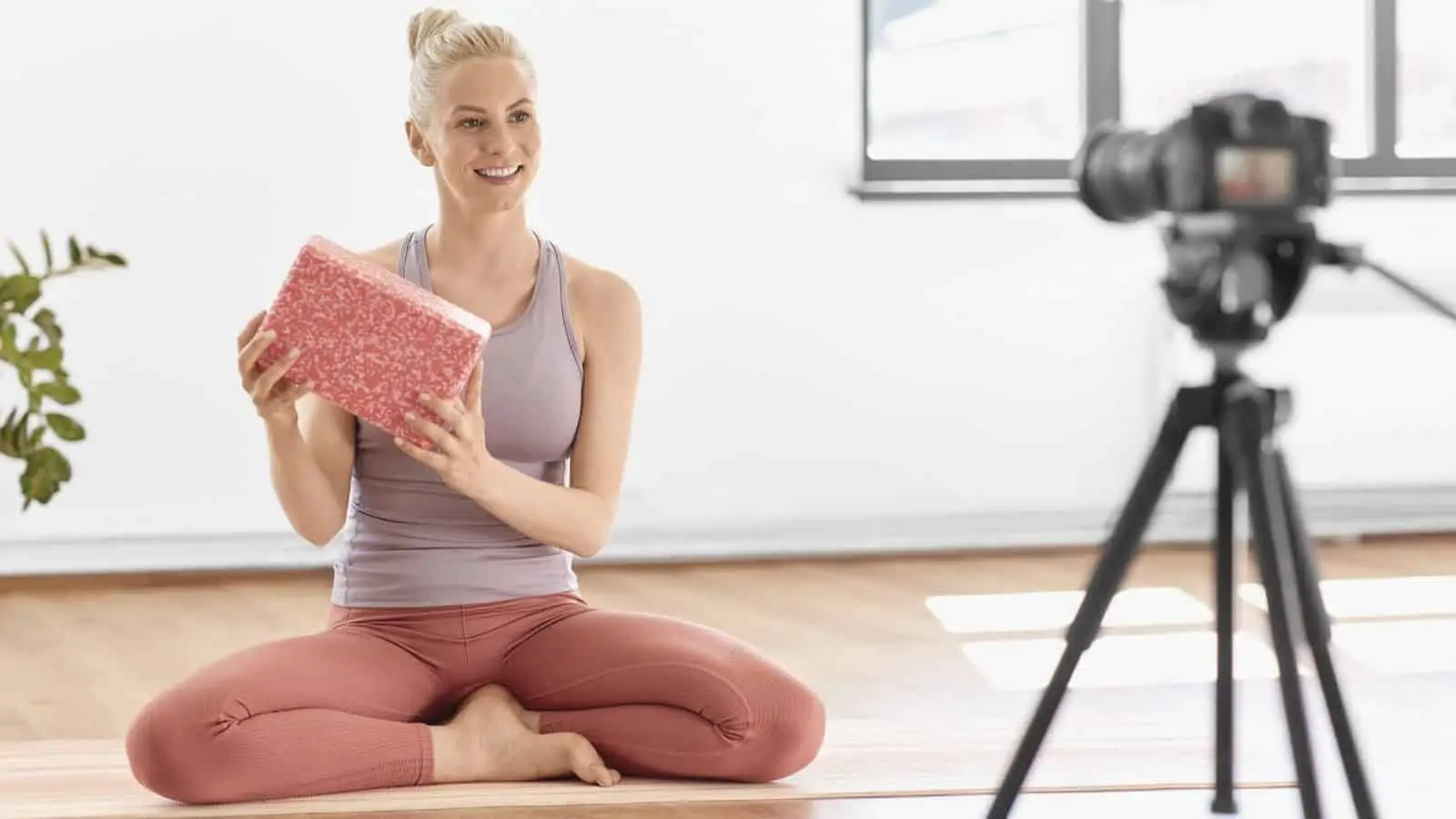Yoga has many physical, emotional, and spiritual benefits attached to the practice that will allow users to grow in many different ways. But sometimes, you may need just a little more than a yoga mat to improve your yoga practice. One of these essential tools is the yoga block. You’d be amazed at how useful and helpful this yoga prop can be when you are practicing yoga. But what is the yoga block, and how can it help you grow in your practice?
The yoga block, also known as the yoga brick, is made to be an extension of your arms, bringing you closer to the ground and enabling you to work on different poses more easily. Beginners and advanced practitioners alike can also use yoga blocks.
In this article, we’ll be exploring everything you need to know about the yoga block. If you’re interested in learning more about this topic, keep on reading.
What Is a Yoga Block?
As we stated above, yoga blocks are a great way to help you express certain yoga poses and forms more easily. They are brick-shaped objects that are usually around 9 x 6 x 4 inches (23 x 15 x 10 cm) in size, and they can be used by anyone, no matter where you are in your yoga journey.
You can find a variety of different kinds of yoga blocks made of a few different materials, such as wood, cork, or foam. It all depends on what you’re most comfortable with and the ways in which you’ll be using your yoga block.
Below we’ll explore how you can properly use your yoga block during your practice, as well as who benefits from these tools the most.
Everyone Can Benefit From a Yoga Block
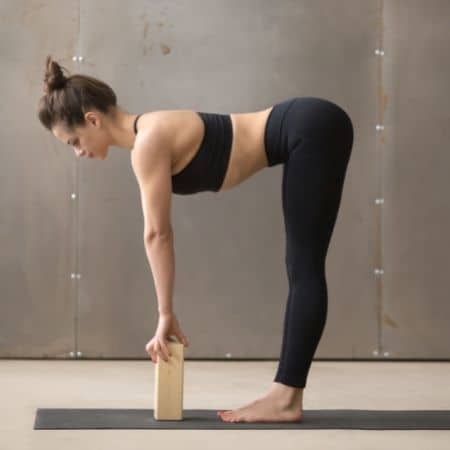
There is a false perception within the world of yoga that if someone uses yoga blocks that aren’t very strong within their practice, and that’s definitely not the case. Anyone from the most advanced practitioners to someone on their first day can get a lot of use out of a yoga block.
As we stated earlier, yoga blocks will allow you to further your range of motion by keeping you closer to the ground when you are practicing new and/or difficult poses. It’s also helpful for those who are more experienced with the poses they are doing, as a little extra support never hurts.
Not only do yoga blocks allow you to reach the ground with more ease, but they are also great for helping you find your balance. This, in turn, allows users to stay within their poses for longer, which allows them to become stronger and more flexible over time.
It’s also helpful to those who may be experiencing the effects of an injury or any other physical limitations that may exist. Keeping these factors in mind will allow you to understand that yoga blocks are just tools that aid you to become a stronger yogi over time.
There Different Types of Yoga Blocks
We stated earlier that there are many different kinds of yoga blocks made of a variety of materials. While most yoga blocks may look the same, there are multiple options available to users.
While most of these differences are small, the size, shape, and the overall material your block is made from will determine how long they will last, as well as if they’re the best option for you.
Softer Blocks vs. Harder Blocks
For one, it’s important to understand the difference between softer blocks and harder, firmer blocks. Softer blocks are ideal for activities such as stretching and enhancing one’s flexibility.
Harder blocks are ideal for more challenging poses and keeping your balance. It’s important to keep factors like these in mind when choosing the best yoga block for you.
The Size and Shape of Your Block
The shape of the yoga block is also important in that it’s more beneficial to users when performing certain poses to use the correct yoga block. For example, due to its curved design, an egg-shaped yoga block is ideal for poses that require you to bend backward.
While yoga blocks can come in different sizes, we stated earlier that the most generic size is 4 x 6 x 9 inches (10 x 15 x 23 cm). Depending on how you angle and lay down your yoga block, they have three different levels available to you that can work for a variety of poses.
In the video below, you can get a closer look into how this yogi positions her yoga blocks to achieve certain poses:
The Material Your Yoga Block Is Made Of
The material your yoga block is made of matters greatly. The material that your block is made of will give you a good estimate in terms of how long your block will last and how durable and eco-friendly it is.
Wood Blocks
Original yoga blocks all consisted of wood (pine wood, Japanese Hinoki Wood) or bamboo, as these were the most durable options available to yogis. Nowadays, wood blocks are made of more sustainable bamboo, making them not only the most durable but the most eco-conscious yoga block available today.
While wood blocks are the most reliable, they can be quite pricey and difficult to transport, seeing how they can be quite heavy. It’s ideal to keep your wood block at home as it’s not a perfect tool to travel with.
Wood blocks are also ideal for strength training and learning how to maintain balance. It’s not an ideal block for those who are looking to perform poses that rely on backbends, seeing how the wood can be quite uncomfortable.
Cork Blocks
Cork blocks are also durable and eco-friendly and another great option for yogis for many different reasons. For one, cork blocks are very comfortable to grip onto, and they are non-slip even when they come into contact with water or sweat.
These kinds of yoga blocks are also ideal for maintaining balance while performing certain poses, so it’s important to be of that. As for the cons, a low-quality cork block may become flaky and start to crumble.
Considering their texture, these blocks are easy to use and maintain, just like a wood or foam block. Different from the wood yoga block, the cork block is relatively easy to travel with.
Foam Blocks
Lastly, foam yoga blocks are popular among yoga beginners because they are a low-cost option. They are also extremely lightweight compared to the other blocks available.
However, it is important to note that foam yoga blocks may not be very durable and may be susceptible to wear and tear. It also should be noted that foam blocks are the least eco-friendly option, so it’s important to be mindful of this factor.
The chart below puts all this information together and will help you better understand the strengths and weaknesses of these materials and what the best option is for you.
| Material | Best For | More or Less Expensive | Pros | Cons |
| Wood | Strength training/balance | More expensive | -Durable-Eco-friendly -Sturdy-Natural look | -Hard to transport -More expensive option |
| Cork | Strength training/ balance | More expensive | -Durable -Eco-friendly -Non-slip | -Hard to transport-More expensive option |
| Foam | Supporting areas, such as the neck, back and pelvis | Less expensive | -Easy to travel with-Most affordable option-Comfortable on more sensitive areas | -Least eco-friendly option -Can be flimsy |
How Yoga Blocks Will Help You
Above, we discussed what exactly yoga blocks are, as well as the many different options that are available to you. Below, we’ll explore how you can get the most out of your blocks and how they will help you grow stronger within your practice.
Achieve Correct Alignment
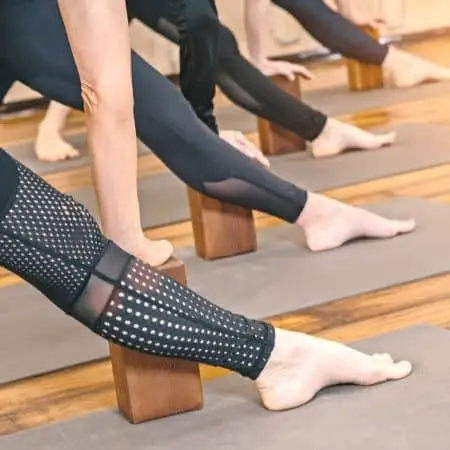
Whether you’re a beginner or someone who is trying to achieve a more challenging and advanced pose, yoga blocks will allow you to achieve the correct alignment more easily and more comfortably.
If you are having a hard time keeping your balance or fully manifesting the correct pose, placing yoga blocks in the correct areas will allow you to reach the correct alignment and find stability. This, in turn, will keep you from straining yourself and potentially injuring your body while your body becomes more flexible over time.
A great example of a pose that requires perfect alignment is the standing forward fold. One of the main reasons many individuals cannot successfully perform a standing forward fold is tight hamstrings.
With yoga blocks, the ground is now closer to you, making it easier for you to execute this pose. Over time, while using your yoga blocks, your flexibility will improve, and your hamstrings will loosen over time, allowing you to perform this pose without your blocks.
Become Stronger
When you can execute yoga poses correctly, you can engage the correct muscles during your practice, therefore making you stronger. Blocks enable you to stay in your pose for longer, as well as correctly.
There are plenty of poses that you can begin using with blocks in order to increase your strength. Poses such as the Chaturanga are ideal for building upper body strength, as well as tightening your core.
While this is a tough pose to master, especially if you’re a beginner, yoga blocks will allow you to execute this pose gracefully and correctly. By placing two blocks underneath your shoulders, you are aligning your body correctly so your core can become engaged.
It’s important to note that while these yoga blocks may be lying underneath your shoulders, you should not be resting solely on your blocks while performing Chaturanga. Your blocks should merely be tools to support you while you learn to do this pose independently without any blocks.
Offer You Support
Not only do you want to feel supported when acting out more strenuous and complicated poses, but you also want to feel supported when performing poses deemed as restorative.
Restorative poses can also be quite strenuous, and yoga blocks can allow you to feel more supported and at ease. There are multiple restorative poses that you can do while incorporating blocks that will allow you to ease any tension in your body while feeling supported.
Hero’s pose is a great example, as it allows you to comfortably stretch your hips and legs. While some complain of tightness being the reason they are unable to hold this pose for too long, yoga blocks will allow you to feel more comfortable and supported.
Sitting a yoga block underneath your seat will provide support to your ankles, making this restorative pose more comfortable and bearable when you’re first starting out. No matter what restorative poses you’re using, a yoga block will allow you to stay in that pose longer, strengthening your muscles as well as your flexibility.
Poses to Try With Yoga Blocks
If you’re new to the world of yoga, many of the poses you’re eager to execute may seem daunting and difficult if you have yet to build up the strength and flexibility. Yoga blocks will enable you to perform these poses successfully as a newbie in the world of yoga.
Below, we’ll explore a handful of poses beginners can perform with yoga blocks that will allow them to grow within their practice.
Camel Pose
To achieve a camel pose:
- Place yourself on your knees and be sure to place them hip-width apart.
- Once you’ve positioned yourself correctly, be sure to tuck in your toes and slowly lean back.
- If you feel as if you can’t reach your feet with your hands, this would be a good time to incorporate blocks into your camel pose. Simply place a block on the outside of each foot to help you feel more balanced.
- You can also place a yoga block between your thighs during camel pose to fully activate the muscles in your legs that you need to use to fully execute this pose.
Camel pose is ideal for those who are looking to improve their posture, as well as strengthening their legs and back.
Crow Pose
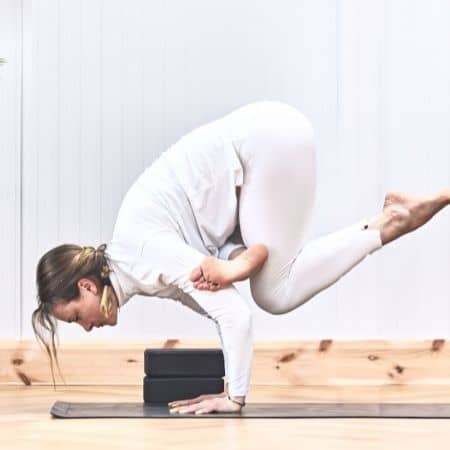
Crow pose is definitely a pose that may seem quite daunting and almost impossible for newbies, but with enough practice, you’ll be able to achieve crow pose.
Similar to the camel pose, you will need two blocks in order to execute this pose successfully. There are a few modifications to crown pose. One of them could be:
- Place the first block horizontally on the ground and stand on it with your feet apart.
- Then place the second block three feet away from the block you are standing on. Ensure that the second block is resting vertically at its highest setting.
- If your block is too close to you while trying to perform a crow pose, you won’t be able to perform this pose adequately; therefore, you won’t be able to reap the benefits.
- Once you’ve done all this, place both your hands on the ground to create an equilateral triangle starting at your hands, traveling down to the block that sits three feet away from you.
- Ensure that your toes are pointed and your elbows are bent straight back. Once you’re locked into position, you can lean forward slightly and lift your hips to achieve a perfect crow pose.
While this may seem like an advanced pose, even a beginner can get the hang of it with the proper tools.
Half Moon Pose
This is a great pose for incorporating the yoga block and can be easily performed by beginners as well as advanced practitioners of the craft. To do the half-moon pose:
- With your yoga block in one hand, spread your feet apart as well as your arms.
- Begin to tilt your pelvis in different directions in order to understand the range of motion your body has, as well as what this movement feels like in general.
- Once you’ve done that, it’s time to shift your weight towards your front foot and eventually over it.
- While doing this, drag your back foot and lift it upwards so that it’s hovering in the air.
- It’s also important to ensure that the front arm that’s seated on the yoga block shouldn’t be directly under your shoulder.
Your yoga block will allow you to stay in this position for longer while also strengthening your arms, legs, and balance.
Fish Pose
Fish pose is classified as a restorative pose in yoga and is a great beginner-friendly pose. This pose will have you lying on your back. To do the fish pose:
- Sit down on your mat and grab two blocks.
- Place the first block underneath your head and one underneath your back. Be sure your blocks are not resting in areas that make holding this pose uncomfortable, such as your ribs or shoulder blades.
- It’s crucial to have your blocks sitting on the correct part of your body. The more comfortable you are, the longer you’ll be able to hold this pose, and therefore you’ll be able to reap the benefits fully.
Starting off the fish pose with blocks is a great way to strengthen your neck and back muscles, especially if you find yourself hurting in those areas.
Full Splits
No matter how far along you are in your yoga journey, achieving full splits can be difficult for anyone. Thankfully, blocks can make executing this pose a whole lot easier.
Once again, you’ll need two blocks to master this move. To do the full splits:
- With both blocks in each hand, lower yourself into a forward lunge.
- With your other leg, slowly begin lowering your knee down until it meets the ground.
- Progressively lower yourself as you continue to breathe deeply.
- Be sure that your hands, as well as your blocks, meet at your hips in order to successfully pull off this pose.
This list can go on and on in the ways a yoga block can assist your yoga practice, but in this article, we wanted to give you an example of how yoga blocks can assist in a few yoga poses.
How to Keep Your Yoga Blocks Clean
Keeping your yoga blocks in good condition is key to having a long-lasting and durable tool. Your block is likely to come into contact with things such as water and sweat, so it’s important to wash your yoga block regularly.
Below, we’ll explore the best ways to keep your yoga blocks clean based on the material your block is made from, as well as some DIY methods that you may benefit from.
Wooden Yoga Block
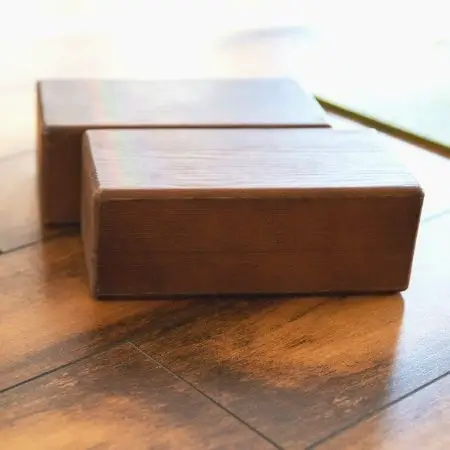
Wooden yoga blocks are the easiest to clean because they aren’t as susceptible to stubborn stains. When cleaning your wooden yoga block, all you’ll need is a wet cloth to wipe off the surface of your block.
This material also doesn’t absorb as easily as a foam yoga block would, so all you’ll really need is a wet cloth and ample time to allow your block to dry. It’s important to set out your wooden block to dry, as the water your block absorbs may damage the interior of your tool.
If you choose to use soap when washing your wooden block, you may, but it’s ideal to use a mild dishwashing soap compared to a hard detergent. You can also use essential oils if you prefer that option, as they won’t cause the structure of your block any harm, and it will add a nice, relaxing scent to your block.
Cork Yoga Block
When it comes time to clean your cork yoga block, a wet cloth is really all you need to do the job. Soap is not necessary when it comes to cleaning this material, so all you’ll really need is water and a good amount of time for your block to dry to clean this item correctly.
If your cork block has any stubborn stains, you can always apply a small amount of organic cleanser to the area, but other than that, you shouldn’t need any other materials.
Similar to yoga blocks made of wood, cork is an all-natural and sustainable material, so it’s important that you follow the basic producers when washing these items in order to preserve them.
Foam Yoga Block
Cleaning your foam yoga block will require a little bit more than a simple wet cloth. Seeing how the foam that makes up your block is more likely to absorb things like sweat, you’ll have to use certain cleaners to fully wash your block.
It’s recommended that you mix a decent amount of dishwashing soap with water and stir it up. Once you’ve stirred up your solution, take a cloth and submerge it into the water. Begin applying the wet cloth to your foam block and make sure to wipe down every inch for the best results.
Once this is done, give your foam yoga block some time to dry off. It’s best to air dry your foam block in order to ensure that your item fully dries off. No matter what kind of material your block is made from, it’s important to give your tool the attention and care it needs in order to preserve it fully.
What Else Do You Need to Know About Yoga Blocks?
We’ve covered a lot of information in this article, from how to execute certain poses with yoga blocks to how these blocks can further your practice and enhance your abilities.
But what else do you need to know about yoga blocks? Below, we’ll explore a few more pointers that are important to know before you purchase your first yoga block.
How Many Yoga Blocks Do You Need?
It’s recommended that you have two yoga blocks if you are a solo yogi. While some of the poses you may be executing may only require one block, many of these poses require two, so it’s ideal to have this many on hand.
You won’t need any more than two blocks at a time during your practice. So when you’re ready to buy the perfect yoga blocks for you, make sure you add two to the cart.
Are Yoga Blocks Worth It?
Yoga blocks are absolutely worth it, and some would even say they’re a necessity for those who are looking to grow within their practice. As we stated above, there is a stigma within the yoga community that yoga blocks aren’t a necessity for those who consider themselves more advanced, but that’s simply not the case.
Yoga blocks are helpful tools for yogis of all levels to grow stronger within their abilities. Yoga blocks are for everyone, and they are definitely worth investing in, so what are you waiting for?
Conclusion
In this article, we discussed yoga blocks in full detail and explained what they are and why they are beneficial to yogis everywhere.
Yoga blocks are simple tools used to make certain poses easier and more accessible, while also strengthening your muscle and your abilities over time. We also went over how to choose the best yoga block for you, what your block can do for you, as well as how to properly care for your yoga block. Hopefully, now you have all the information and tools you need to get started. Don’t be afraid to purchase your yoga blocks today and get started.

